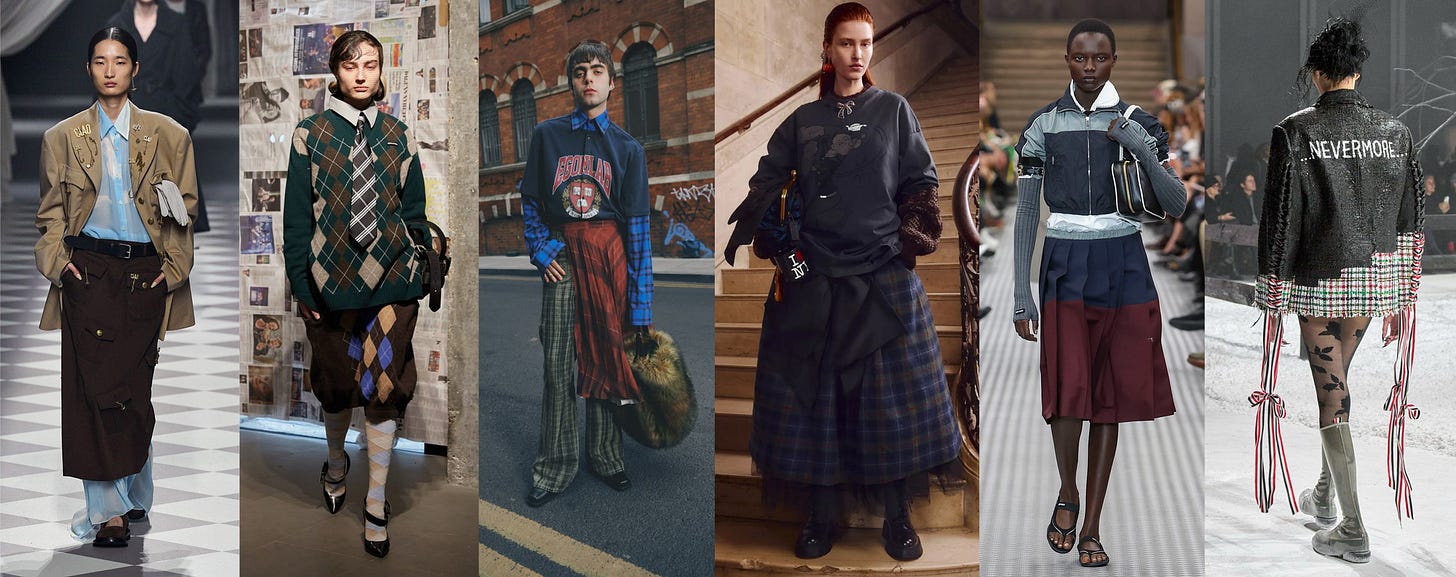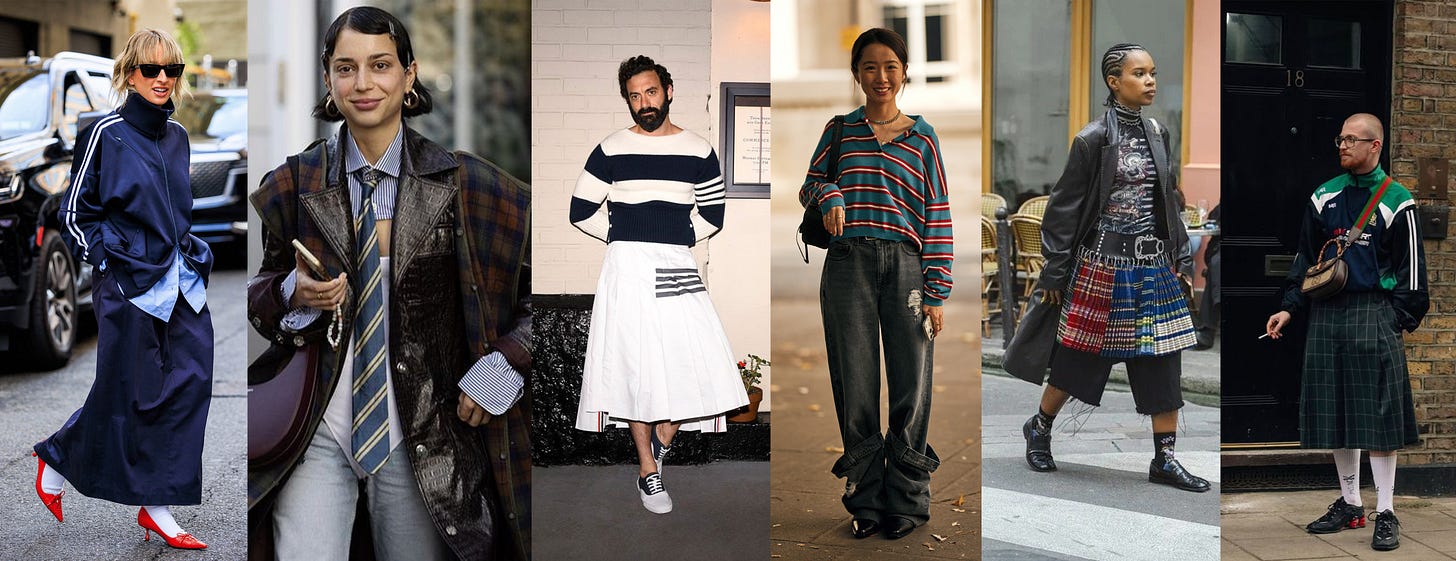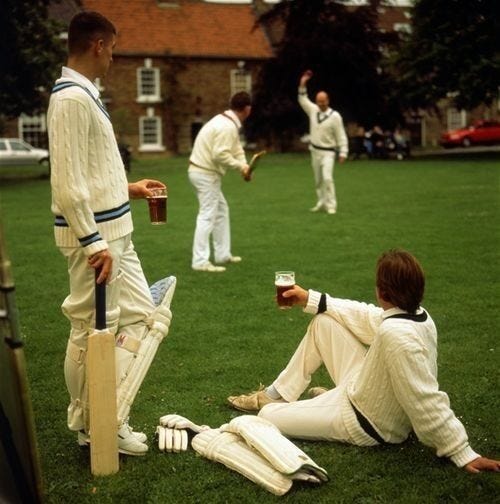As the age old adage says, we want what we can’t have. Quiet luxury had staying power for a reason. The Walmart Birkin took over the internet. Pinterest’s “Rococo Revival” has us cosplaying as Marie Antoinette while our taxes skyrocket. The serfs pretending to be queens. Even the logomania of the 2010s was a gaudy attempt at showing wealth, while realistically most of the goods were DHGate dupes and back-room Canal street knockoffs. Entire Zara looks paired with the viral Acne scarf, tag facing out obviously, with a fake Louis Vuitton Neverfull and SUPREME stamped across our chests. (I did in fact have a “supreme” sweatshirt. It’s in quotations because I bought it on the street in Seoul for $10.) No one escaped the 2010s unscathed. We just pretend that our current fashion, which will inevitably change in response to the world around us, a sign of the times if you will, has dramatically improved compared to the looks from the last decade. I’m sure we’ll all have things to cringe about in another ten years. But I digress. I’ve strayed from the point. We will do whatever we can to show status and wealth, regardless of our reality.
Take Ivy was published in 1965. The Official Preppy Handbook was released in 1980. These dramatically impacted the fashion of the 60s and late 1900s (typing 1900s made me want to throw up). Early prep days were the golden age for college graduates. The average home cost was $11,000 ($98,000 adjusted for inflation), while the median household income was around $5,600. There was no “5 years experience” needed for entry level jobs. And so college graduates entered the workforce, bought homes, and lived a comfortable life. Ergo, their prep-iness was associated with success. (yes, this is a very simplified summation, lacking nuance for women, minorities, and anyone who wasn’t white, male & middle class to begin with.) As a white middle class woman raised in a pretty sheltered Connecticut suburb, I know I already come from this place of privilege. It is not my place to write about this experience from any other perspective. I will however, encourage you to read this article, written by Kendra James about her experience as a black woman at a Connecticut prep school, and how black people have contributed to and participated in prep culture.
But, like I said, people like to aspire to live the lives of those they deem successful. Well, it’s now 2025. The median cost for a house is $419,000. The median household income is $80,6101. The job market is saturated, and AI is killing off even more of the slim pickings. The average cost of college in the US is $38,270 per year2. Notice something? It’s nearly half of the average income. Not to mention that our current political climate has twisted intelligence and education into a “woke” issue that needs to be extinguished. “Smarty-pants”, “know it all”, “nerd”, (derogatory) have been playground taunts for years. Online commenters rage against the machine by claiming students attending college are being brainwashed by professors, screaming that scientists and researchers are pushing an agenda. Because who wouldn’t want to spend their entire life struggling to change the world and improve things around us, only to be mocked and taunted that they are a pawn in the system? I could think of easier and much less stressful paths. It’s easier to put others down that to raise yourself up. And the media is pushing this agenda. Bye NYT, hello HuffPost. Peace, love, state-run media. (If I sound angry and bitter, it’s because I am. I recently had a boy - I’m calling him a boy because he obviously does not have the critical thinking skills required to be categorized as anything else - I went to high school with slide into my DMs demanding “lemme know which rights are actually being taken away”. I said I am NOT about to hold you hand through this one, broke it down for him in a very easily digestible numbered list, and his big comeback was that the government has checks and balances in place to ensure we maintain our rights as written in the constitution. I then sent him our VP’s declaration that judges have no right to restrain the president's agenda. So much for checks and balances. He has since not responded.)
For context, this is the prep to which I am referring:
So, you can look at it one of three ways:
Prep is being reclaimed by the working class
It’s a bid to be perceived as something we simply aren’t. Educated.
We’re reverting to yay rah-rah American conservative values.
The upper class hates when the lower class follows in their footsteps.
Why do the British have notoriously bland food? Because with the boom of the spice trade working class consumers were finally able to afford luxuries previously only afforded to the very wealthy. On their quest to remain exclusive, the rich reverted to spice-less food to separate themselves from the undesirables. And so a country of bland cuisine was born.
The complete opposite can be true as well.
It could be that everyone is so tired of seeing mediocre white men wear clothing that no longer represents them and have in turn adopted it as a method of resistance and protest. This could quite easily explain the Miu Miu prep renaissance - women from all demographics and backgrounds are doing the work now and in turn have co-opted the look. According to usafacts.org, “White, US-born adults are the largest group of those with low literacy skills, making up 35% of low-skilled adults.”3 So as the pendulum always does, maybe we’re swinging around to the other side: cool prep. Or maybe this is the pendulum returning to the side it came from: rich, exclusive, and definitely classist prep.
And so, we may run our brains around in circles trying to rationalize which reason it may be, when at the end of the day, it really comes down to one thing: prep is conservative. Prep is exclusive, and prep is elitist. Designers dish out pleated skirts and country-club attire and lux wool blazers on their silver-platter runways, making it aspirational yet again, under the guise of heritage all while calling it classic. And it remains elitist. Because who is really affording these so-called subversive takes on prep? These people already wearing button downs with cashmere slung over their shoulders and toting understated thousand dollar Ralph Lauren purses and Longchamp weekenders. And yes, eventually these runway trends will trickle down to our regular mainstream retailers, but these $200 options will lack the nuance and subversion that fashion houses explore.

Most people wear clothing because it’s trending. Most people also don’t research the history behind fashion movements and growth. And so by the time prep makes its way from the runways into department stores and eventually into fast fashion, it has lost the undertones of rebellion that its initial revival had been aiming to comment on. Thom Browne has forever put men in skirts. The new (and short lived) Gossip Girl (and no, I did not watch it) explores the queer experiences of a diverse cast, while still within the original world and society.
As Rachel Tashjian so eloquently put it in this article," “This is one of the downsides of trend-brain: We distill our understanding of a past “aesthetic” into the most digestible or immediate form, compressing out the beautiful and complicated and weird stuff in the process. As one of the best books on the history of prep, Black Ivy, articulates (coinciding with the prep renaissance, the book was released in 2021), preppy clothes are not nearly as white and exclusive as we might imagine. Button-downs, khakis, and crewneck sweaters have a long history as a uniform of “revolt,” as author Jason Jules puts it, for Black Americans.”
So while there is a history to prep that many of us have yet to explore, and some designers may be aiming to comment on the classist characteristics of the exclusionary elite, those who are donning these garments are already aware of the messaging. I don’t think we’ll be seeing any conservative men in Thom Browne’s iconic knee high socks and kilts, and I highly doubt any republican women are rushing to embrace Chopova Lowena’s punk take on pleated mini skirts or Wales Bonner’s working class streetwear inspired tracksuits.
In reality our country is reverting to its conservative values, under the guise of Americana and good ol’ Christian morals. And our fashion has been following suit. The right is donning button downs and slacks while stripping our Department of Education.
Where are we going to wear our pleated skirts and tennis shoes if we have no schools to attend? So, twist as you may, twist as you might, there’s no way to twist this in which prep exists without its conservative undertones.
Side note: Desi looked great in Thom Browne. Maybe resistant forms of prep will become more mainstream after all outside of just an exclusive group of fashion girls (and even fewer fashion boys). We need more menswear for women, more punk prep styling, and more playing with silhouettes. Prep is historically fitted - well, let’s go baggy prep. Pull an England - adopt their style and make them change their tune. And I still love my rugby shirts.
https://www.census.gov/library/publications/2024/demo/p60-282.html
https://educationdata.org/average-cost-of-college#:~:text=Average%20Cost%20of%20College%20%26%20Tuition&text=Report%20Highlights.,CAGR)%20of%20tuition%20is%204.04%25
https://usafacts.org/articles/which-states-have-the-highest-and-lowest-adult-literacy-rates/









as someone who casually loves fashion, I’m thinking— though it’s important for people to be properly compensated for their work, I do wonder sometimes about designers who want to make statements about class structure with their pieces while also pricing their garments exorbitantly. is it enough sometimes to just leave them as art pieces and not necessarily selling them???
such an interesting thought because just as you said, these runway pieces have so much nuance that will be absent by the time it gets to the fast fashion websites making it difficult for the working class to participate. Maybe the solution is DIY haha